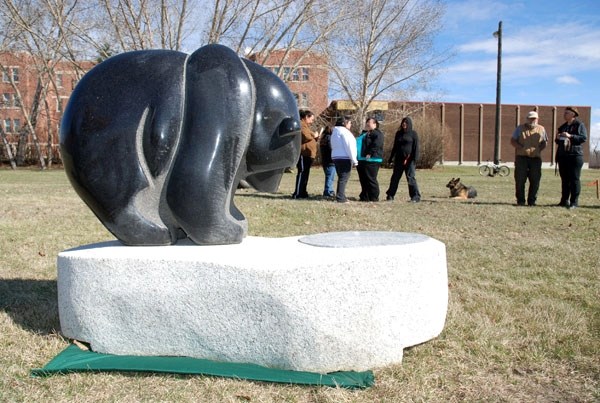A healing garden, rooted in the land by Blue Quills First Nations College, is one that organizers hope will restore people’s connection with the environment around them, bring healing to past wounds, and “prepare our future so we have a lot of strong, healthy human beings,” according to Lana Whiskeyjack.
Whiskeyjack, an instructor at Blue Quills, said she wanted to bring a healing garden to the college for a long time, particularly since one of her best friends is a healing garden designer. Both of them felt people today live most of their lives indoors. “We both are mothers; we wanted our children to get outside as much as possible, instead of watching TV or playing games,” said Whiskeyjack.
Since Blue Quills is a former residential school, a healing garden also made sense, with healing a central part of the First Nations college’s vision. Thanks to a nearly $50,000 grant from the Truth and Reconciliation committee, the college was able to commission a sculpture by Stewart Steinhauer, an artist originally from Saddle Lake, which will stand at the centre of the garden.
On May 3, members of the community gathered at Blue Quills to install the sculpture, entitled Mother Bear Praying for Earth’s Healing, with chants and songs.
The healing garden will, coincidentally, be built on the same land where children once used to work a vegetable garden back in the days when Blue Quills was a residential school, said Whiskeyjack. She hopes to see a vegetable garden created again in the plot, so that the generations can reconnect with the idea of growing their own food, with the produce then being used to make meals for the college’s diner.
As part of the healing of wounds created by colonialism and residential schools, Whiskeyjack invites community members of all cultures to come and take part in the planting, which is set to coincide with the college’s annual culture camp, to be held May 28 to June 1.
Whiskeyjack’s friend, Karin Adshead, donated her time to designing the garden. She describes the long-term vision as one where people will walk through a mixed meadow to reach a ring of dogwood bushes, with four entrances to the circular garden inside. The four entrances, representing the four directions, will be comprised of four arches made of teepee poles. The walker will pass through rings of flowers, each ring reflecting a colour of the rainbow.
Those circles upon circles are also symbolic, said Adshead, “representing how when you have an experience, you build on it. It doesn’t go away, it’s part of who you are.”
Adshead is amazed by how the community members have taken ownership of the project and have run with it, a feeling echoed by Whiskeyjack. “It’s already generating a lot of good energy,” Whiskeyjack said, adding people are calling her and asking how they can be involved.
“A project of this scale has a way of taking a life of its own and bringing out the best in people. Part of the healing process has already started with people working together to a common goal, and recognizing they have something to contribute,” said Adshead, adding the healing has already begun. “That’s a big part of it right there, before the garden even gets planted.”



